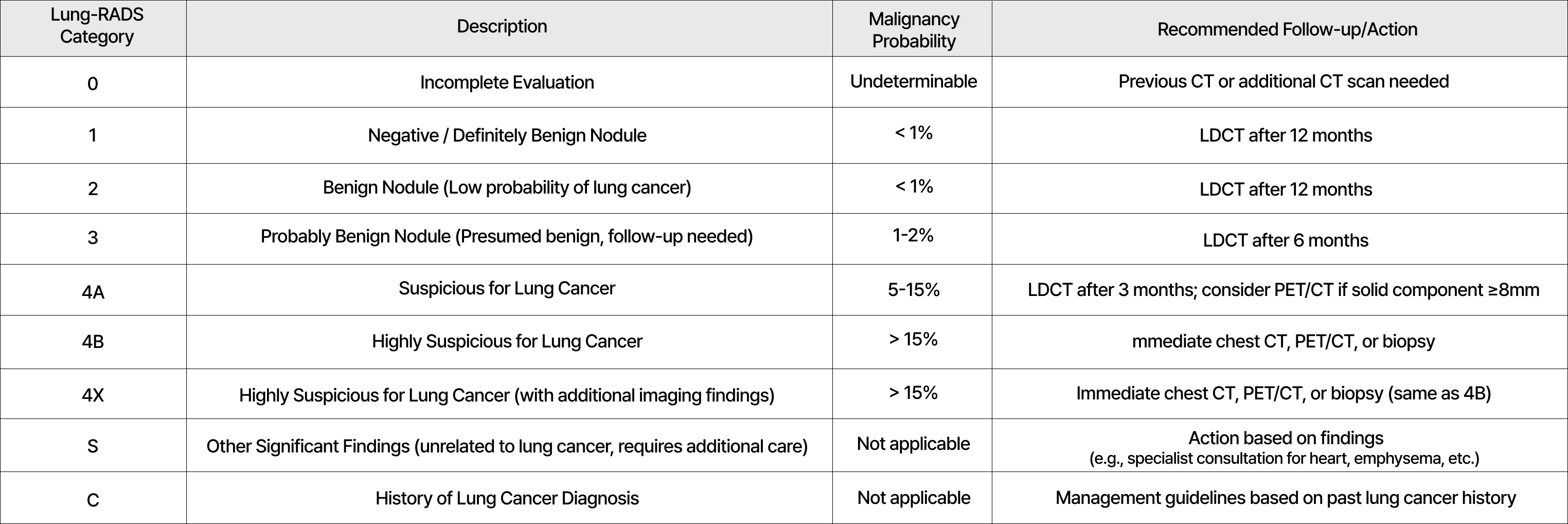After undergoing a low-dose chest CT (LDCT) scan for lung cancer screening, the most anticipated aspect is likely the results. Lung CT scan results are not simply categorized as 'normal' or 'abnormal'; they are reported in a detailed manner through a standardized system called 'Lung-RADS.' This article aims to help readers understand their screening results and plan their next steps by thoroughly explaining what Lung-RADS is, what each category signifies, and what follow-up observations are recommended accordingly.
What is Lung-RADS?
Lung-RADS (Lung CT Screening Reporting and Data System) is a standardized reporting system for lung cancer screening CT results and for tracking individuals with abnormal findings. It was introduced by the American College of Radiology (ACR) and is widely used worldwide, with continuous improvements. This system classifies lung nodules found on CT scans into categories from 0 to 4X based on their characteristics, size, and time of discovery, providing recommended management guidelines for each category.
Key Lung-RADS Categories and Their Meanings
Lung-RADS classification serves as a crucial criterion for predicting the likelihood of lung cancer and determining appropriate follow-up actions.
- Category 0 (Incomplete Evaluation): This category indicates that the evaluation is incomplete, requiring a previous chest CT scan or an additional chest CT scan.
- Category 1 (Negative): No suspicious findings for lung cancer, or lung nodules that are definitively benign. The malignancy probability is less than 1%, and a regular LDCT screening is recommended after 12 months.
- Category 2 (Benign Nodule): Nodules with a very low probability of lung cancer, requiring a regular check-up after 1 year. The malignancy probability is less than 1%. This includes solid, part-solid, or ground-glass nodules below a certain size, or nodules that have shown no change in size for 3 months or more.
- Category 3 (Probably Benign Nodule): Lung nodules presumed to be benign, but with a 1-2% chance of malignancy, requiring a follow-up examination within 6 months. Solid, part-solid, or ground-glass nodules of a specific size may fall into this category.
- Category 4A (Suspicious for Lung Cancer): Lung cancer is suspected, requiring a follow-up examination within 3 months. The malignancy probability is 5-15%. This includes solid or part-solid nodules above a certain size, or those showing signs of growth. If the solid component is 8mm or larger, PET/CT may be considered.
- Category 4B, 4X (Highly Suspicious for Lung Cancer): A very high possibility of lung cancer, requiring urgent additional examination. The malignancy probability exceeds 15%. Immediate chest CT, PET/CT, or biopsy is recommended. Specifically, Category 4X applies to nodules in Category 3 or 4 that are accompanied by additional imaging findings highly suggestive of malignancy, such as lung consolidation, atelectasis, lymphadenopathy, or spiculated margins.
- Category S (Other Significant Findings): Findings other than lung nodules that are unrelated to lung cancer but require additional examination or treatment for other lung or chest conditions.
- Category C (Known Lung Cancer History): This category refers to individuals with a past history of lung cancer diagnosis.
Lung-RADS categorizes nodules based on their size, characteristics, and time of discovery, providing management guidelines accordingly. However, the application of 'Category 4X' when accompanied by 'highly suspicious imaging findings' like lung consolidation or lymphadenopathy, and 'Category S' for other significant findings unrelated to lung cancer, demonstrates that Lung-RADS does not solely rely on numerical or objective criteria. The comprehensive clinical judgment and experience of a radiologist remain crucial. While a standardized system enhances efficiency, 'human expertise' in considering complex individual patient situations cannot be replaced, which is also why training skilled personnel is essential for quality control in screening.
Follow-up Observation Guidelines Based on Screening Results
The frequency and method of follow-up observations vary according to the Lung-RADS category. For example, Category 2, which has a low probability of lung cancer, recommends an LDCT after 1 year, while Category 4A, suspicious for lung cancer, requires a follow-up examination within 3 months. During the follow-up period, CT scans are not necessarily performed every time; initially, they might be done every 6 months for the first 2 years, and then annually with CT or PET scans thereafter. Recent studies have also suggested that examining every 3-6 months offers no clinical advantage over annual examinations.
Lung-RADS provides specific follow-up observation cycles for each category. The ultimate goal of a screening program, 'mortality reduction,' is achieved not merely by detecting cancer but by ensuring 'appropriate and timely follow-up actions' for detected abnormalities. This suggests that a screening program must integrate not only technical diagnosis but also comprehensive 'patient journey management,' including patient education, communication, and access to care.
Importance of Post-Screening Management
To maximize the effectiveness of lung cancer screening, thorough post-screening management of results is essential. It is crucial for patients to visit the screening institution for direct consultation with a doctor. This provides an opportunity to understand their lung health, even if no abnormalities are found, and to receive information on improving lifestyle habits for future lung cancer prevention.
Furthermore, during the result consultation, comprehensive guidance is provided, including smoking cessation counseling and information on the types of confirmatory tests and potential side effects if abnormalities are found. Accurate result reporting and patient-centered communication are vital to reduce unnecessary anxiety and ensure prompt referral to the next stage of care when needed.
Lung-RADS Classification and Recommended Guidelines

Lung-RADS is more than just a numerical system. Properly understanding the results and accurately implementing the necessary follow-up actions are key to the success of early lung cancer detection. Screening is merely the beginning; the effectiveness of lung cancer prevention is only fully realized when it is followed by post-screening management, communication with doctors, and lifestyle improvements. After receiving screening results, it is crucial to consult directly with medical professionals to accurately understand your lung condition, reduce unnecessary worries, and not miss any necessary actions.
Lung Cancer Screening Series
1. The Importance of Lung Cancer Screening: Early Detection Changes Survival Rates
2. Mastering Lung Cancer Screening Methods: What is Low-Dose CT (LDCT)?
3. Lung Nodules Found on Lung Scans – Are They Always Lung Cancer?
4. Lung Cancer Screening Eligibility Checklist: Do You Qualify?
5. (This Article) Interpreting Lung CT Scan Results: Understanding Lung-RADS
6. Common Questions About Lung Cancer Screening: Myths and Facts
7. The Future of Lung Cancer Screening: How AI and Liquid Biopsy are Changing the Landscape
8. National Lung Cancer Screening: Do I Need It? Age and Cycle Summary



 List
List


